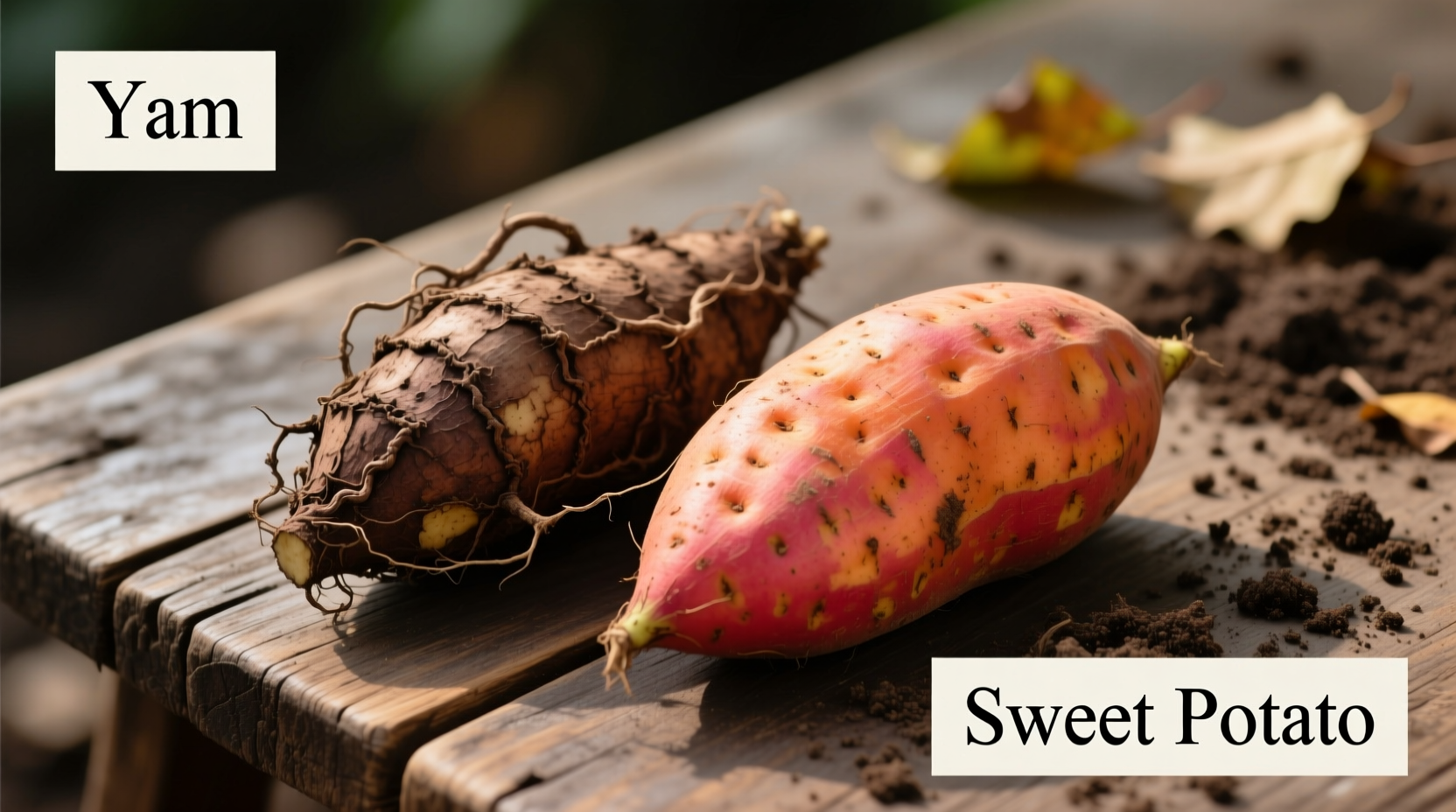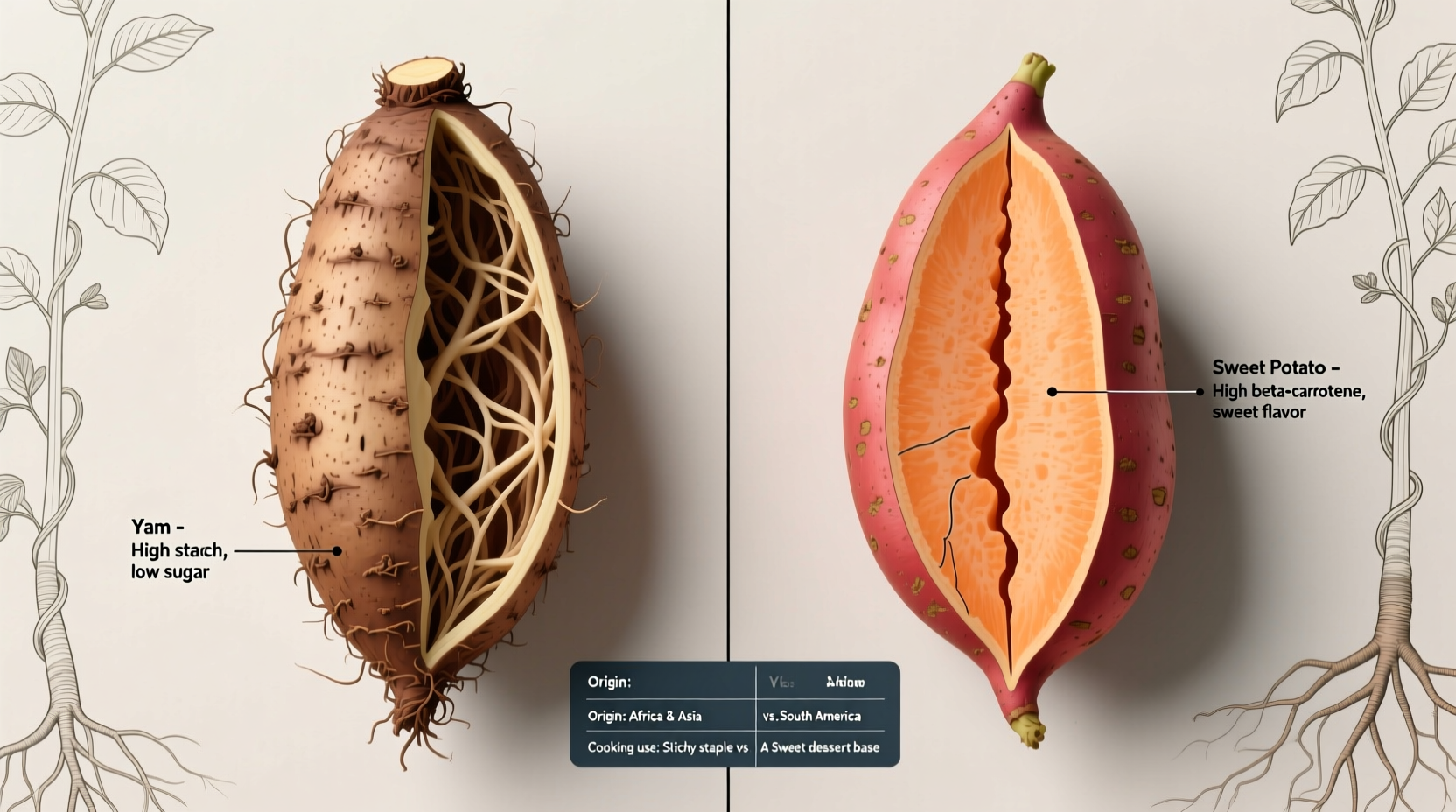No, yams and sweet potatoes are not the same. Despite common confusion in American grocery stores, they belong to different plant families with distinct characteristics. This guide reveals the key differences in appearance, nutrition, and culinary uses to help you identify and select the right tuber for your recipes.
Ever stood in the produce aisle wondering why some "yams" have orange flesh while others are pale? You're not alone. This widespread confusion stems from historical marketing practices in the United States that mislabeled sweet potatoes as yams. Understanding the real difference matters for both your cooking results and nutritional choices. Let's clarify this common culinary misconception once and for all.
The Historical Mix-Up: How Sweet Potatoes Became "Yams"
The confusion began in the early 20th century when orange-fleshed sweet potatoes entered the U.S. market. To distinguish them from traditional pale sweet potatoes, producers borrowed the African word "nyami" (meaning "to eat") and marketed them as "yams." The U.S. Department of Agriculture now requires labels specifying "sweet potato" when orange varieties are sold as "yams," yet the misnomer persists.
| Characteristic | True Yams | Sweet Potatoes |
|---|---|---|
| Botanical Family | Dioscoreaceae | Convolvulaceae |
| Native Region | Africa, Asia, Caribbean | Central/South America |
| Texture | Starchy, dry, less sweet | Moist, sweet (orange varieties) |
| Shelf Life | 6+ months | 3-5 weeks |
| Skin Texture | Bark-like, rough | Thin, smooth |
How to Identify Them in the Grocery Store
True yams are rarely found in standard American supermarkets. What's labeled as "yam" is almost always a sweet potato variety. Here's how to tell what you're really buying:
- Orange-fleshed varieties (like Jewel or Garnet): Marketed as "yams" but are actually sweet potatoes
- Pale-fleshed varieties (like Hannah or O'Henry): True sweet potatoes, often labeled correctly
- True yams: Have blackish, bark-like skin and white/purple flesh; typically found in African or Caribbean markets

Nutritional Differences That Matter
While both provide valuable nutrients, their profiles differ significantly. According to USDA FoodData Central, a medium sweet potato (130g) contains 103 calories, 24g carbohydrates, and 438% of your daily vitamin A needs. True yams have slightly fewer calories (118 per 100g) but significantly less vitamin A. Sweet potatoes' vibrant orange color comes from beta-carotene, which converts to vitamin A in your body—a nutrient virtually absent in true yams.
Cooking Implications: Why the Difference Matters
The moisture content dramatically affects cooking results:
- Sweet potatoes (especially orange varieties): Higher sugar content creates caramelization when roasted. Ideal for pies, casseroles, and mashing.
- True yams: Drier texture makes them better for boiling or frying. Commonly used in West African fufu or Caribbean stews.
Substituting one for the other can alter recipe outcomes. For example, using a true yam in sweet potato pie would result in a less sweet, drier filling without the characteristic orange color.
Where to Find True Yams
If you're seeking authentic yams, check specialty markets:
- African grocery stores (often labeled as "nyami" or "coco yam")
- Caribbean markets (look for "malanga" or "yautia")
- Asian markets (sometimes sold as "ube" though this is technically a different variety)
True yams require longer cooking times and often need soaking to reduce natural bitterness. Their starchier composition makes them a dietary staple in tropical regions where they've been cultivated for over 50,000 years—significantly longer than sweet potatoes' 5,000-year history of cultivation.
Why does my grocery store call sweet potatoes yams?
U.S. producers began using "yam" in the 1930s to distinguish orange-fleshed sweet potatoes from traditional pale varieties. The term stuck despite USDA requirements to label them as sweet potatoes.
Can I substitute yams for sweet potatoes in recipes?
Not ideally. Sweet potatoes have higher sugar and moisture content, creating different textures and flavors. Substituting true yams in sweet potato recipes will yield drier, less sweet results without the characteristic orange color.
Which is healthier, yams or sweet potatoes?
Sweet potatoes contain significantly more vitamin A (as beta-carotene) and vitamin C. True yams provide more potassium and fiber. Both are nutritious, but sweet potatoes offer greater antioxidant benefits due to their vibrant pigments.
How do I store sweet potatoes properly?
Store in a cool, dark, well-ventilated place (55-60°F). Never refrigerate, as cold temperatures convert starches to sugars. Properly stored sweet potatoes last 3-5 weeks, while true yams can last 6+ months under similar conditions.











 浙公网安备
33010002000092号
浙公网安备
33010002000092号 浙B2-20120091-4
浙B2-20120091-4